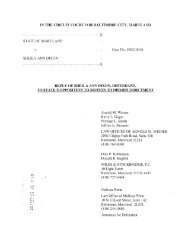Motion in Limine to Exclude Evidence of Other Acts - Dixon
Motion in Limine to Exclude Evidence of Other Acts - Dixon
Motion in Limine to Exclude Evidence of Other Acts - Dixon
Create successful ePaper yourself
Turn your PDF publications into a flip-book with our unique Google optimized e-Paper software.
evidence that the Defendant actually committed the other bad acts.3 See id. at 809, 724<br />
A.2d 111; Ayers, 335 Md. at 632-34, 645 A.2d 22. Third, the proponent <strong>of</strong> the evidence<br />
must demonstrate that the probative value <strong>of</strong> the bad acts evidence outweighs any undue<br />
prejudice likely <strong>to</strong> result from its admission.4 See Streater, 352 Md. at 810, 724 A.2d<br />
111; Harris, 324 Md. at 500-01,597 A.2d 956.<br />
These substantive and procedural protections are necessary <strong>to</strong> guard aga<strong>in</strong>st the<br />
potential misuse <strong>of</strong> other bad acts evidence and <strong>to</strong> avoid the risk that the evidence wil be<br />
used improperly by the jur aga<strong>in</strong>st a Defendant. See Streater, 352 Md. at 807, 724 A.2d<br />
111. '''The evidence may not be used merely as a ruse <strong>to</strong> accomplish the prohibited<br />
objective' <strong>of</strong> prov<strong>in</strong>g a person acted <strong>in</strong> conformity with his or her character." ¡d.<br />
(citation omitted). The rule acknowledges the risk presented by a jury's tendency <strong>to</strong><br />
improperly <strong>in</strong>fer from unrelated bad conduct that the Defendant committed the crime for<br />
which she is charged. See Streater, 352 Md. at 810, 724 A.2d 111; Taylor, 332 Md. at<br />
334, 701 A.2d 389. Thus, the trial court must carefully exam<strong>in</strong>e the nature and purpose<br />
<strong>of</strong> the evidence sought <strong>to</strong> be <strong>in</strong>troduced. See Streater, 352 Md. at 8078-08, 724 A.2d<br />
111; Ayers, 335 Md. at 632, 645 A.2d 2. In order <strong>to</strong> be admissible, therefore, the other<br />
bad acts evidence must be reasonably necessary <strong>to</strong> establish the elements <strong>of</strong> the charged<br />
<strong>of</strong>fense. See Streater, 352 Md. at 810, 724 A.2d 111; Faulkner, 314 Md. at 642-43, 552<br />
A.2d.896.<br />
3 This determ<strong>in</strong>ation protects the Defendant aga<strong>in</strong>st the risk that unsubstantiated charges <strong>of</strong> past misconduct<br />
wil unduly <strong>in</strong>fluence the jury. See Streater, 352 Md. at 809, 724 A.2d I I I; Lodowski v. State, 302 Md.<br />
691, 728,490 A.2d 1228 (1985), rev 'd on other grounds, 307 Md. 233, 513 A.2d 299 (1986).<br />
4 Underly<strong>in</strong>g this prong <strong>of</strong> the Faulkner test is the concern that other bad acts evidence is general1y more<br />
prejudicial than probative. See Streater, 352 Md. at 810, 724 A.2d i i I; Taylor, 347 Md. at 369, 701 A.2d<br />
389. Prejudice may result from a jur's <strong>in</strong>cl<strong>in</strong>ation <strong>to</strong> convict the Defendant, not because it has found the<br />
Defendant guilty <strong>of</strong> the charged crime beyond a reasonable doubt, but because <strong>of</strong> the Defendant's unsavory<br />
character or crim<strong>in</strong>al disposition, as ilustrated by the other bad acts evidence. See Streater, 352 Md. at<br />
810,724 A.2d i i i; Taylor, 347 Md. at 369, 701 A.2d 389.<br />
5

















